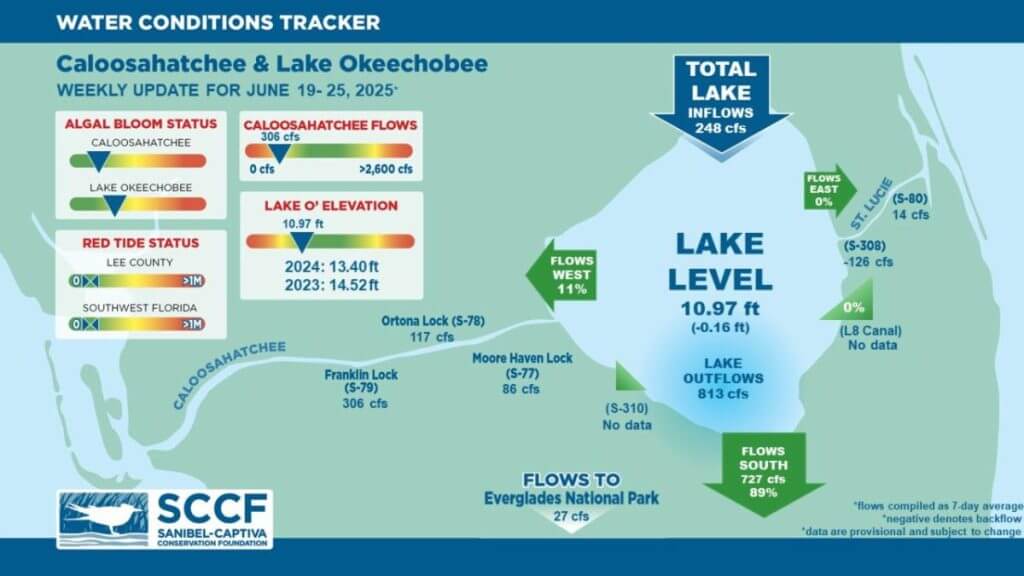Fort Myers Beach Water & Beach Conditions
Know before you go!
ADVISORIES AND UPDATES FOR FORT MYERS BEACH WATER & BEACH CONDITIONS
Public Water Quality Monitoring Station At The Mound House
Get real time data on water quality from the Mound House and other water quality stations here.
Florida FWC Red Tide Report (July 2, 2025)
Over the past week, the red tide organism, Karenia brevis, was not observed in samples collected statewide. We continue to use satellite imagery (USF and NOAA NCCOS) to help track nearshore and offshore conditions.
No fish kills suspected to be related to red tide were reported to FWC’s Fish Kill Hotline or other partners over the past week.
Respiratory Irritation suspected to be related to red tide was not reported over the past week in Florida. For forecasts that use FWC and partner data, please visit the National Oceanic and Atmospheric Administration’s Gulf Coast Harmful Algal Blooms Forecast.
Caloosahatchee Conditions Report (July 1, 2025)
Flow to the Caloosahatchee Estuary had a 7-day average of 381 cfs at S-79 with a 7-day average of 74 cfs (19%) coming from the lake at S-77. The 14-day moving average flow at S-79 was 339 cfs and has been below the optimum flow envelope (<750 cfs) for 11 days after 15 days in the optimum flow envelope (750- 2,100 cfs; RECOVER 2020). The 14-day moving average flow at S-77 was 79 cfs.
Florida Department of Environmental Protection
Weekly Update June 20 – June 26, 2025
There were 64 reported site visits in the past seven days with 64 samples collected. Algal bloom conditions were observed by samplers at 16 of the sites.
Sanibel Captiva Conservation Foundation

South Florida Water Management District
May 5, 2025 – May 11, 2025
The latest Weekly Environmental Conditions Report is now available.
Headlines
Encore: Why rainy season fertilizer ordinances are so important in reducing harmful algae blooms
LOSOM officially finalized, governing Lake Okeechobee operations
‘What’s in the water?’: FGCU study reveals state of Fort Myers Beach waterways
New Decals Are Out To Support Manatees & Turtles
What kind of fish can you catch in the Fort Myers Beach canals?
Fiscal Year 2025-26 Budget Invests Billions in Everglades Restoration and Water Quality
OTHER SOURCES OF INFORMATION
Check out these other useful links for up to date information on water quality issues such as red tide, and blue-green algae.
- Florida Healthy Beaches Program (Florida Department of Health)
- Lee County Updates
- Sanibel-Captiva Conservation Foundation Recon News
- Current Beach Conditions (MOTE Marine Laboratory)
- FMB CHAMBER RESOLUTION NO. 19-01 (SUPPORTING GOVERNOR RON DESANTIS’ STRONG COMMITMENT TO WATER QUALITY, EVERGLADES RESTORATION AND THE SIGNIFICANT FUNDING LEVELS OUTLINED IN EXECUTIVE ORDER 19-12)
INFORMATION ON TYPES OF HAZARDOUS MICROORGANISMS
Red Tide
In Florida, red tide is caused by a microscopic single-celled algae called Karenia brevis or K. brevis. It is present in background conditions throughout the year in the Gulf of Mexico. When natural conditions are right, the organism can form blooms producing a toxin. When red tide is present it can cause coughing, sneezing and teary eyes. People with asthma or chronic respiratory problems should avoid red tide areas. Swimming in water with red tide can also cause skin irritation or eye burning.
Please refer to this fact sheet for more information on red tide.
You can also find lots of useful information on the Captains For Clean Water Red Tide Conditions Page.
Blue-Green Algae
Cyanobacteria/ blue-green algae are a group of organisms that can live in freshwater, salt water or mixed “brackish” water. When conditions are right, such as warm water and increased nutrients, these organisms can increase in numbers and accumulate in some areas of a water body.
Blue-green algae can cause gastrointestinal effects if swallowed. Children and pets are especially vulnerable. If you spot blue-green algae, please contact Kalina Warren, environmental administrator with DEP’s Water Quality Assessment Program for the South Region at 407-897-4177.
You can find more information on blue-green algae using the links below:
Florida Department of Environmental Protection
Vibrio Vulnificus
Vibrio vulnificus is a bacterium that normally lives in warm seawater. Itis part of a group of vibrios that are called “halophilic” because they require salt. Occurring naturally in the warm coastal waters, particularly during the summer months, Vibrio vulnificus has the potential to cause serious illness. People can get infected with Vibrio vulnificus when they eat raw shellfish, particularly oysters. Persons who have wounds, cuts or scratches and wade in estuarine areas or seawater where the bacteria might be present can become ill as well.
Symptoms of Vibrio vulnificus in wound infections typically include swelling, pain and redness at the wound site. Other symptoms of Vibrio vulnificus infection include; nausea, vomiting, abdominal pain, diarrhea, fever, chills and the formation of blistering skin lesions. Individuals experiencing these symptoms should contact a physician immediately for diagnosis and treatment.
Please refer to this fact sheet for more information on Vibrio vulnificus.
REPORTING DEAD MARINE LIFE
For sick, injured or dead sea turtles contact the Sanibel-Captiva Conservation Foundation Sea Turtle Hotline at 978-SAVE-ONE (728-3663) or FWC’s Wildlife Alert hotline at 888-404-FWCC (3922). FWC’s hotline can also be used to report any sick or dead animal.
To report a fish kill, contact FWC’s Fish Kill Hotline at 800-636-0511 or submit a report online. The public can also download the free FWC Reporter app to their mobile device.
